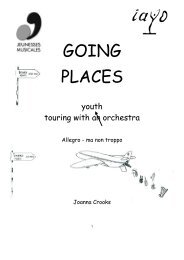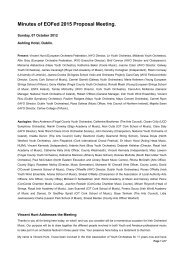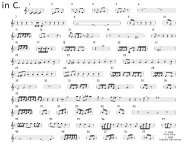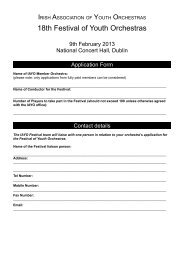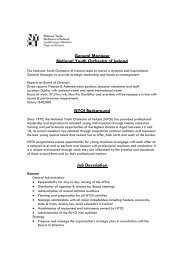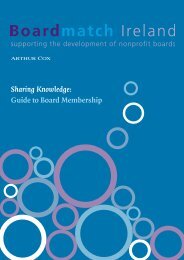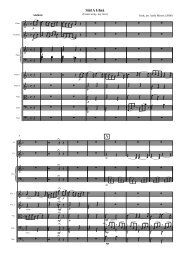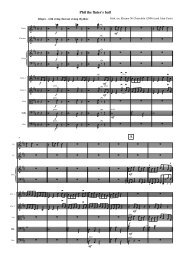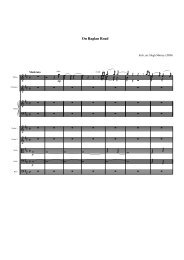A SOUND EAR II - Association of British Orchestras
A SOUND EAR II - Association of British Orchestras
A SOUND EAR II - Association of British Orchestras
Create successful ePaper yourself
Turn your PDF publications into a flip-book with our unique Google optimized e-Paper software.
A <strong>SOUND</strong> <strong>EAR</strong> <strong>II</strong><br />
Since then, other studies have also shown high levels <strong>of</strong> hearing damage in musicians. Heili Laitinen found:<br />
% <strong>of</strong> Respondents<br />
Tinnitus Hyperacusis Distortion Diplacusis<br />
All<br />
24<br />
25<br />
12<br />
5<br />
Women<br />
18<br />
31<br />
14<br />
6<br />
Men<br />
27<br />
21<br />
11<br />
4<br />
Eskko Topilla found that levels <strong>of</strong> threshold shift were similar to the general public, but tinnitus and hyperacusis were<br />
both four times more common.<br />
Tinnitus 2 is triggered and aggravated by many factors, one <strong>of</strong> which is certainly noise. Two people with identical<br />
threshold shift will have quite different tinnitus experiences, but there is little doubt that increased noise exposure<br />
increases the risk <strong>of</strong> developing tinnitus, even if there is no clear correlation with the intrusiveness <strong>of</strong> that tinnitus<br />
(which is dependent at least as much on the character <strong>of</strong> the tinnitus as on its volume). We found that 35-40% <strong>of</strong><br />
musicians have frequent or occasional tinnitus, with the woodwind being much more likely than other sections to<br />
report frequent tinnitus. Other researchers have found that a fifth <strong>of</strong> players have permanent tinnitus, and 2/3 have<br />
tinnitus after rehearsals or performances (demonstrating temporary hearing damage). Of the players with tinnitus, we<br />
found that 30% are bothered by it and 6% are very bothered (at least double the level for the general population).<br />
Hyperacusis is an over-reaction to some noise. You will be familiar with the way your ears prick up when you<br />
hear your name mentioned, or hear a phrase that interests you: this is due to a survival mechanism in which the brain<br />
increases the volume <strong>of</strong> noise it considers to be important. This can be noise which has a special interest for you,<br />
which represents special responsibilities (eg. your child) or is associated with danger. Regrettably, noise associated<br />
with stress or pain is classified as dangerous. When players are exposed to noise that hurts them, or which increases<br />
performance stress by preventing them hearing their own output or actually preventing them playing for a moment<br />
(because <strong>of</strong> the shock), their brains activate the ‘dangerous noise’ defence mechanism – and make the noise seem<br />
even louder. More than a quarter <strong>of</strong> the woodwind report hyperacusis. The reflex can also activate the fight-flight<br />
mechanism, leaving a player shaking with adrenalin and with muscles tensed.<br />
Hyperacusis is not ear damage, but a learned change in perception and with help it can, to a degree, be unlearned.<br />
13<br />
Recruitment can seem to be the same as hyperacusis, but it is not. As the stereocilia become damaged,<br />
each one becomes less sensitive and less specific. This will happen to a group <strong>of</strong> stereocilia, with the result that<br />
none <strong>of</strong> them reacts to a very quiet noise. Eventually, as the noise increases, it hits the (new) trigger point <strong>of</strong> the<br />
damaged stereocilia. As the noise increases, an increasing number <strong>of</strong> neighbouring (damaged) stereocilia also start<br />
reacting – whereas in an undamaged ear the reaction would be restricted to a much smaller range <strong>of</strong> stereocilia. The<br />
consequence is that as a given noise level rises, the damaged ear hears nothing, nothing, nothing, nothing, something,<br />
lots, far too much – as the floor <strong>of</strong> your hearing rises, so too the ceiling <strong>of</strong> your hearing comes down.<br />
Cocktail party effect occurs when hearing damage makes it difficult to distinguish a particular noise<br />
against high background noise levels. For many people, this is only a social disability but for musicians, it also means<br />
you cannot listen to particular instruments against the general sound <strong>of</strong> the orchestra.<br />
Diplacusis results from your ears having a significant difference in frequency selectivity, producing clashing<br />
interpretations <strong>of</strong> the tonal content <strong>of</strong> the noise. Because it is unusual to have the same damage in both ears, this is<br />
not uncommon.<br />
2<br />
Tinnitus - the perception <strong>of</strong> abnormal sound whose location is within the body - is quite common. There are<br />
many, many causes but some occurs when regions <strong>of</strong> the brain tuned to frequency regions that have become<br />
damaged are reassigned to the same frequency regions <strong>of</strong> adjacent areas, leading to a sort <strong>of</strong> aural doubleaccounting:<br />
A high proportion <strong>of</strong> people have some experience <strong>of</strong> tinnitus: 10% <strong>of</strong> the under-50s and some<br />
40% <strong>of</strong> the over-50s have tinnitus that is bothersome in the quiet. About 5% experience moderate to severe<br />
annoyance, 1% find it has a severe effect on their quality <strong>of</strong> life, and 0.5% suffer a severe effect on their ability to<br />
lead a normal life.



